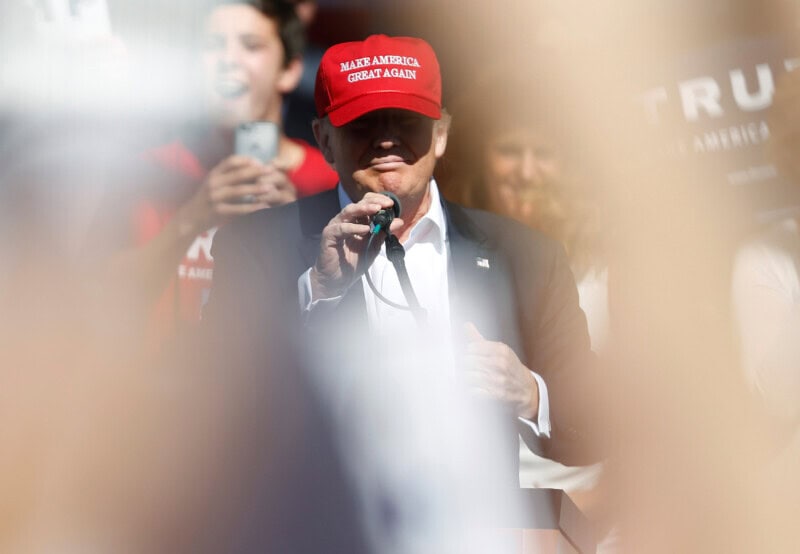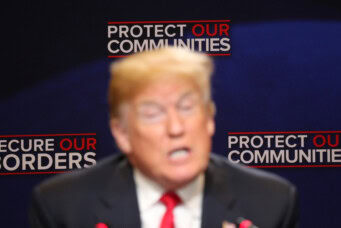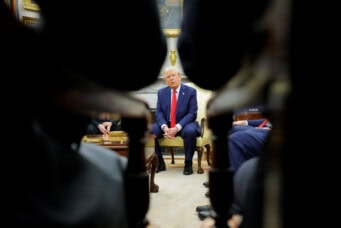Donald Trump and the Art of Bending Reality
The gravity-defying political comeback of Donald Trump is the pinnacle of the chaotic career of an extreme risk taker with little concern for established norms. But his willingness to upend rules and bend reality to suit his vision might push U.S. and global politics to the breaking point

In the early 1970s, at the beginning of his career as a real estate developer, working alongside his father Fred, Donald Trump already demonstrated the penchant for bending reality to impose his preferred narrative, a trait that would become the defining feature of his political persona. Faced with a lawsuit by the Justice Department for allegedly discriminating against African Americans applying for housing in the Trump company’s real estate projects, he hired notorious New York lawyer Roy Cohn, former aide of Joseph McCarthy in the “red scare” era and legal advisor to prominent bosses of organized crime. Cohn, who was to become his mentor for over a decade, advised Trump to deny all the allegations and to countersue, accusing the Justice Department of defamation. It was a brazen strategy: not only did the Trump organization not discriminate, the counterlawsuit argued, but the company’s reputation had been unjustly tarnished. The Trump company eventually settled, but never admitted to any bias against black applicants, despite the trove of evidence to the contrary collected by the prosecutors. Trump claimed victory, and walked away with some of the most important of Cohn’s advice: never apologize, always attack, and use the media to project a successful image.
By the early 2010s, Cohn’s advice had helped Trump survive through four decades marked by great achievements and spectacular downfalls, by global expansions and bankruptcies, by legal disputes and sexual scandals. These were the hallmarks of a tumultuous business career and personal journey, one that landed him on the cover of tabloid magazines and on millions of TV screens as the host of the reality tv show “The Apprentice”. It was around that time that Trump found the perfect platform to impose his vision on millions of Americans: social media. On Twitter, Trump reinvented himself once more, and found an ideal outlet to stay in the public eye and to allow his erratic personality to connect with the most volatile segments of the American public opinion. Only this time the stakes were higher: Trump was not anymore the billionaire playboy, the maverick businessman or the savvy entertainer, willing to forego marital fidelity, to skirt the law and host a T.V. show to salvage his finances. In an era of widespread public unrest that was triggered by the 2008 financial crisis, Trump gradually started to position himself as the bellicose champion of voters disaffected with the political establishment, unafraid of picking quarrels and of hurling insults at politicians or celebrities, of once again breaking the rules and bending reality to suit his ambition. In the matter of a few years, with the help of Twitter, Trump styled himself as the perfect demagogue for the social media era, and as the most audacious exploiter of the populist sentiment sweeping across most Western democracies.
Shift in Mediated Politics
Political discourse in the 2010s was also changing around what was going to become a recurring element of current political conversations: conspiracy theories. Trump was quick at recognizing this cultural and political trend, and tapped into the growing paranoid attitude of Americans to advance his political agenda, increasingly defined by a willingness to upend the political consensus and break with norms, protocols and sensitivities. The opportunity came in the form of the so-called “birther” conspiracy, alleging that then U.S. President Barack Obama—the first African American to serve as president—was not born on American soil and thus didn’t meet the requirements to sit in the Oval Office. It was, of course, an obvious lie that had emerged from the fringes of Twitter and other social media, carrying not-so-subtle racist undertones. It eventually died out despite the vocal championing by Trump, who had frequently amplified it via his account. The conspiracy theory, however, persisted in the news cycle long enough to pressure Obama to show his birth certificate in order to settle the matter once and for all. Reality didn’t bend at Trump’s will, just as it didn’t when he sued the Justice Department four decades prior, but circulating a conspiracy theory had forced a sitting president to publicly address it, thus somehow making it sound less outlandish. Joining the “birthers” had also helped raise Trump’s political profile among far-right and nationalist circles, giving him enough of a popularity boost to convince him that he was on the right track. People were indeed eager for someone that, at least rhetorically, would take their side and act as a raucous and reckless mouthpiece for their disaffection with politics as usual, for the constraints of political correctness, and for the dogmas of neoliberal globalist economy.
Trump’s now famous descent from the golden escalator in the Trump Tower, when he announced his intention to run for president in the 2016 election, officially marked the opening of a phase of dramatic changes in politics and political communications, labeled by some scholars and commentators as the “post-truth era”. While theoretically a bit fuzzy, post-truth is nonetheless a useful catch-all concept to identify a cultural and political context in which emotional appeals and personal opinions have a greater influence in shaping public opinion than objective facts. Trump embodied the post-truth ethos when in his speech railed against “Mexico sending people with lots of problems” and “rapists” to the United States, effectively conjuring up a distorted version of reality that captured the imagination of millions of Americans. The actual data about immigration of course paint a completely different picture: migrants are less likely to engage in criminal activities than native U.S. citizens, crime rates in the United States dropped while immigration was on the rise, and migrants have an overall beneficial effect on the American economy. However, in the post-truth era—a complex phenomenon related to a plurality of cultural, political and economic factors, compounded by the communicative logics of social media—facts and data don’t hold much sway. Emotional storytelling, sensational stories, lurid details, no matter if fabricated, fare much better.
When Trump was elected president in 2016, his casual relation with facts and his endorsement of conspiracy theories was perceived as an aberration of the established norms of public discourse. Post-truth was considered a temporary epistemological crisis that could be remedied by promoting media literacy, investing in fact-checking initiatives and enforcing stricter regulations on social media platforms. At best, the political and cultural establishment in the United States and Europe accepted Trump’s brand of populism as a sort of necessary warning signal needed to fix some parts of the liberal democracy apparatus that had been left a bit loose, especially with respect to the impact of technology on society and politics. Indeed, technology companies started to face more scrutiny after 2016, and responded with implementing more robust content moderation and fact-checking of their content. The widespread consensus at the time was that Trump represented a passing ailment, a short-lived intrusion into the otherwise healthy body of American institutions. This perception of Trump as an interference was reinforced by the discovery that hostile State actors, such as Putin’s Russia, had weaponized American social media in an effort to alter the electoral process, to further polarize American society and to amplify the most radical voices, above all that of Trump himself.
The Rhetoric of Division
Studies and publications emerging during the first Trump campaign and presidency mostly focused on his divisive rhetoric, on his unpredictable and aggressive personality, on his unorthodox approach to politics and government, and on the forms and formats that he had imported into the political arena from his previous experience as a businessman and reality tv personality. Aside from his circles of fervent supporters, Trump was seen as little more than a snake oil salesman that had bluffed and blustered his way into the most powerful position of power in the world. Reality, the assumption went, was eventually going to catch up with him and expose him as an utter fraud. And it did, at least at first. Most of his campaign promises from 2016 – above all, the border wall that Mexico was going to pay for – never materialized. The so-called “Muslim Ban” and the Zero Tolerance Policy on immigration proved to be either too poorly conceived or too controversial to be implemented in their original form. Prominent newspapers such as The New York Times routinely debunked misinformation and disinformation pushed by Trump, exposing his lies and empty rhetoric. And when the Covid-19 pandemic hit in early 2020, Trump and his administration were found grossly unprepared. Trump underestimated the threat posed by new disease, and even promoted controversial or hazardous remedies, such as injecting disinfectant. It was most likely the mishandling of the pandemic—with its enormous human and economic toll on American society—that cost Trump the presidency in 2020. When he refused to concede and instead mounted a legal and political challenge against the outcome of the election, it seemed that Trump had become irreversibly separated from reality. His final, desperate attempt to bend it in his favor by spinning the “Stop the steal” disinformation campaign and inciting supporters to storm Capitol Hill on January 6th 2021, was widely considered as the last chapter of his political career.
A common criticism about Trump is the notion that he is thin-skinned and can’t handle disappointments. While it is true that he is easily offended and doesn’t respond well to criticism, Trump has demonstrated throughout his career an uncanny ability to bounce back from failures, to fight against overwhelming odds and to perform near seamless shape shifting from one embodiment to another: businessman, media personality, politician. Trump has internalized the lessons of his most influential mentors and associates: his father, who taught him how to survive in the cut-throat, zero-sum-game world of New York real estate, the already mentioned Roy Cohn, and Roger Stone, a ruthless Republican political operative and lobbyist, who was the first to suggest to Trump the idea to run for president, already in the late 1990s. Most of all, Trump is someone that, by his own admission, thrives in chaotic and volatile contexts, and who once said: “When bad times come, I can get whatever I want.” And no period of his long career has been worse for Trump than the past four years, except maybe the early 90s, when several business failures had left him “poorer than a homeless man”, as he confessed to his daughter Ivanka. In the years after the tragic events of January 6 2021, Trump was embroiled in several investigations, and was regarded by many, including in his own Republican party, as a political pariah, someone who had committed the capital sin of attacking the very foundations of American democracy. Trump was done.
A Party Transformed
And yet, he was not done. By the time the 2024 election cycle came around, it gradually became apparent that Trump had irreversibly altered the Republican party around his own image. The MAGA movement—the embittered, loyal and almost messianic base of Trump supporters—had become the real core of the GOP, sidelining more moderate politicians and voters. The Republicans who had disavowed Trump after January 6, one by one began realigning themselves as they started to realize that there was no alternative to him. Perhaps begrudgingly, or out of calculation, they nonetheless accepted Trump was not a passing fad, or a transient anomaly, but a structural, deeply-rooted presence in the landscape of American conservative politics. The pinnacle of this process was one of the most egregious examples of reality bending that Trump has conducted in his political career: the rewriting of January 6th from a seditious attempt by dangerous extremists at subverting the democratic process, to a legitimate act of resistance by true patriots against a conspiracy concocted by the ‘deep state’ to steal the election from him. January 6th had been “a day of love”, as Trump claimed on several occasions. A conspiracy theory wasn’t just accepted as the basis for violent political action, it was sublimated to a morally pure and noble sentiment. The bending of reality was nearly complete.
To finish the staggering transformation of American politics and society around his own cynical and self-centered vision that he had started in 2015, Trump had to enlist the most powerful propaganda machine ever invented: social media. The technology that had jump-started his political career a decade before – and that almost derailed it after 2016 when technology executives reluctantly responded to government pressure to moderate users and verify content – had to be tamed and brought into the fold. To complete this process Trump found an unexpected ally in Elon Musk, a visionary billionaire attuned to the same political vision: socially and fiscally conservative, anti-immigration, ethno-nationalist and fundamentally anti-democratic.
Musk had charted his own path from business to politics, similar to that of Trump, over the course of the past four years, as Trump was waiting for his moment to step back in the limelight after the 2020 debacle. Musk, also an avid and savvy Twitter user, and a self-proclaimed free speech absolutist, had signaled repeatedly his antipathy towards content moderation on social media, and promised to allow back Trump—together with other controversial figures that had been deplatformed from Twitter—once he had completed the acquisition of the platform. Musk eventually bought Twitter in late 2022, rebranding it to X and implementing drastic changes to the content moderation policies, while also taking a much more active political stance in support of far-right politics. The trajectories of the two men, who also share similar egomaniac tendencies and conspiracy-theory prone mindset, finally overlapped in 2024, when Musk openly supported Trump for president and donated over 250 million dollars to his successful campaign. To the dismay of researchers and citizens concerned with the impact of social media in public life, Meta’s Mark Zuckerberg has announced the intention to scrap his platform’s content moderation policies, to better position them in a political and business environment dominated by the likes of Trump and Musk.
If one should single out the most significant difference between the Trump campaign in 2016 and that of 2024 is that the notions of misinformation, disinformation and conspiracy theories have transformed. They are not, as they say in the tech lingo, a bug but a feature of contemporary political discourse, and under the second Trump administration they are going to inform policy making, and influence both domestic and international politics. Trump has successfully bent political reality in America to align with his own reckless, chaotic and radical view of the world. A vision that sadly benefits the wealthy few and gravely threatens the poor, the minorities and marginalized—as seen in the gutting of USAID—and that could upend the democratic order in the US and compromise an already strained global security architecture. Furthermore, the conspiracy theories mindset is encroaching into the private sphere, threatening people’s health and safety. Trump has nominated Health Secretary Robert F. Kennedy, who despite raising important questions on overmedication and chronic diseases, has nonetheless circulated health misinformation and is a notorious vaccine skeptic. His appointment could turn into the most serious assault on public health in recent American history. And in the even more dangerous realm of defense and security, Trump has chosen people with extreme views and dubious democratic credentials such as Pete Hegseth and Tulsi Gabbard, to respectively lead the US military and the national intelligence. The bending of reality is complete. In doing so, however, Trump has pushed it to the point where reality as we know it might soon break, with potentially dramatic consequences for America and for the whole world.




